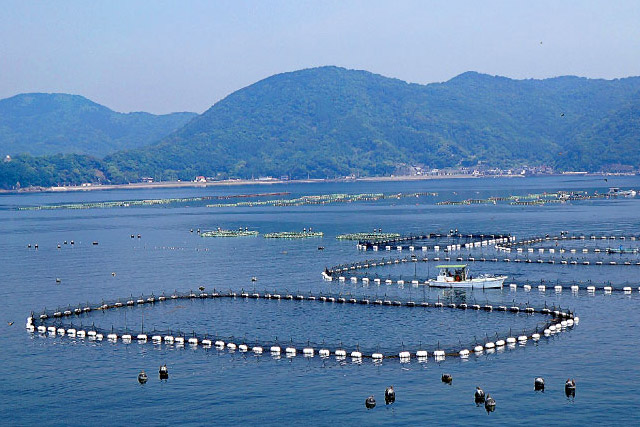Land-based production: Securing the sea’s bounty for the next generation
Crafting a sustainable future with land-based production
In the fall of 2017, researchers from the Maruha Nichiro Central Research Institute set out for Yuza, a seaside town in Yamagata Prefecture overlooking the Japan Sea. Their mission? To start field testing for a series of experiments and research into inland cherry salmon aquaculture that had begun that February.
This project is based on a proposal we submitted through the Field for Knowledge Integration and Innovation (FKII)®, which is sponsored by the Ministry of Agriculture, Forestry and Fisheries’ Council of Industry-Academia-Government Collaboration. A consortium of six participating bodies set the research initiative in motion.
The volume of natural fishery products caught worldwide rose in the late 20th century from 20 million tons to 90 million tons, but global warming and overfishing caused it to level out in the 1990s. In the 2010s the output from aquaculture surpassed that of natural fishery products, which has affected people’s dietary habits as well.*1
Salmon*2 is the favorite sushi item of Japanese people. But most of the salmon that we eat is imported Atlantic Salmon or trout—non-native species. Despite being an ocean nation, we are eating fish imported from far overseas.
Japan’s chief sources of salmon and trout, such as Norway and Chile, are blessed with topography, water temperature, and water purity that is well suited to salmon aquaculture. By leveraging these features to operate large-scale seawater aquaculture facilities, they have acquired an overwhelmingly competitive market advantage that has enabled them to meet continually growing demand. But unfortunately, very few ocean areas suitable for aquaculture are left. Since a stable supply of fishery products depends on aquaculture, it is imperative that we make the next move. And that move is land-based production.
While climate change and wars are destabilizing the food situation worldwide, the United Nations estimates that the world’s population will reach 9.7 billion in 2050. With fishery products serving as an essential source of protein, this field testing sought to find out whether safe and delicious fish will still be available for future generations.
*1: FAO FishStat study (Global capture production)
*2: Maruha Nichiro study (Annual consumer survey on kaiten-zushi 2022)
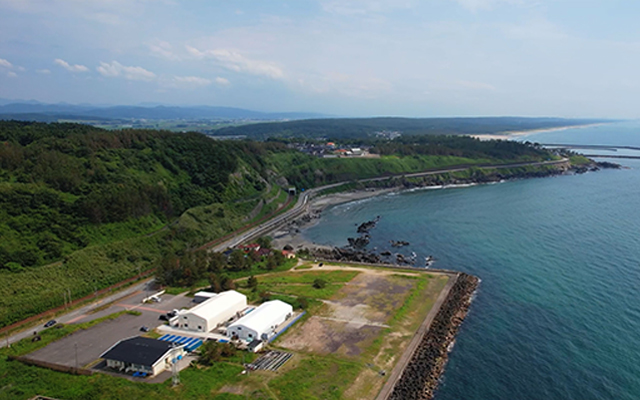
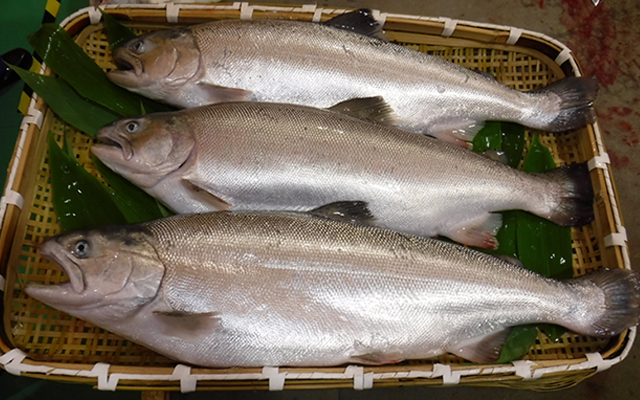
Cultivating a native Japanese species that’s nearing endangerment
Japan’s aquatic resources are in peril. If we don’t start working now on breeding and hatchling production, indigenous breeds may become endangered. In terms of protecting biodiversity, too, it seemed sensible to do the experimental production using a breed indigenous to Japan. So our initial aim was to create a business engaging in local production for local consumption.
The first hatchlings (known as “fry”) were supplied by Yamagata Prefecture, a project member. Cherry salmon are iconic of Yamagata Prefecture, but wild-caught ones cannot be eaten raw due to the risk of infection with parasitic insects such as Anisakis*3. Land-produced cherry salmon, on the other hand, are raised on feed mixtures and have safety as an advantage. If we could produce them at a stable shipping volume, this would allow the prefecture to promote cherry salmon more as a local food. And the fish also have high added value as a tourism resource. Consequently, locals had high expectations for these fry.
And yet, it turned out that the fry wouldn’t eat the feed we gave them at all. Since cherry salmon are Yamame fish that have swum downstream to the sea, we had them give us Yamame fry intended for releasing into the river. These are hatchlings that are raised as natural fish, so as they mature, they internalize the idea that “people are dangerous” as a way to avoid being caught.
We tried all kinds of methods to feed them without letting them see that there were people involved, but nothing worked. Eventually, we changed course and requested Yamagata Prefecture to provide special water tanks just for the test hatchlings, and we had someone go feed them at the hatchling production facility every day until they got used to people. As a result, the fry who came to recognize people as the ones who gave them food began to eat well and grow big. The larger fish were selected as parent fish, and then we repeatedly selected for breeding those who grew fast and had better physiques. After conducting four hatchling production experiments over the project’s 4-year duration, we succeeded at reaching an average weight of 2 kilograms.
*3: When the fish eat plankton, they ingest the Anisakis right along with it, and the parasites remain intact in the fish’s body.
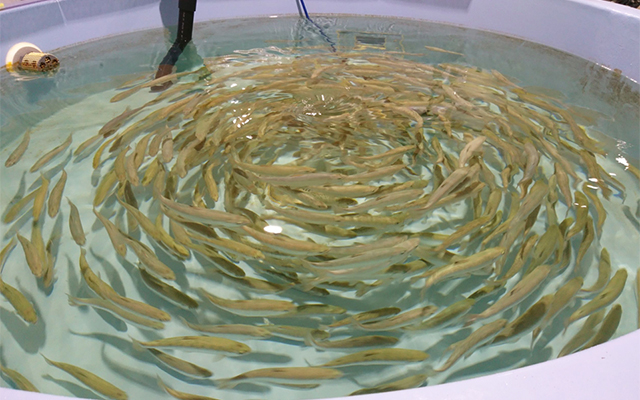
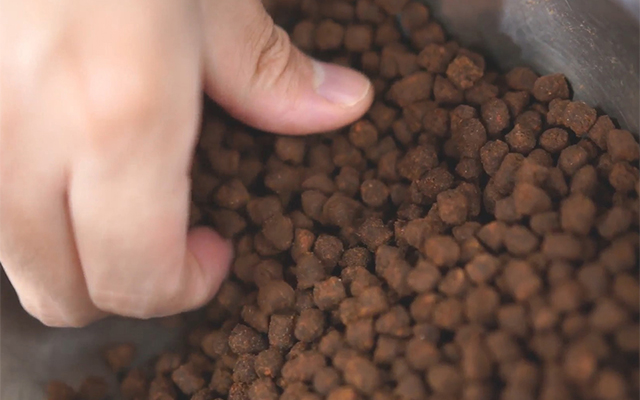
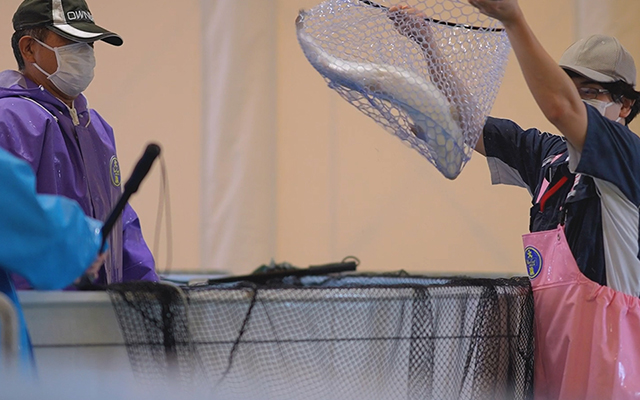
From field test to project phase
More important than the numbers was this project’s stark contrast to Japan’s conventional salmon production. Why did we choose cherry salmon, which no one had attempted the difficult task of raising before? Here’s how one researcher explained it.
“Most Japanese salmon production uses eyed eggs*4 imported from overseas. But that prevents the industry in Japan from building up its expertise in breeding and hatchling production. With aquatic resources at risk of depletion, the world’s aquaculture businesses may eventually be primarily land-based. And it would be too late to start at that point.”
As a result, those efforts have already been set into motion. In October 2022, Maruha Nichiro turned its attention to Nyuzen Town in Toyama Prefecture, where, together with the Mitsubishi Corporation, it established the joint venture company ATLAND Corp. to conduct land-based production of Atlantic salmon. The field tests in Yuza Town could be considered as laying the groundwork for Japan’s salmon and trout aquaculture to move in the right direction. After the Industry-Academia-Government Collaboration project ended, we partnered with a new framework that took over the research, and we have started experimental rearing aimed at developing an aquaculture business for both cherry salmon and other salmon. The water tanks at Yuza Town now have Atlantic salmon swimming in them.
*4: Eyed egg: An egg at a stage at which the fish’s eye is visible to the naked eye through the egg’s membrane.
Deep sea water sharply reduces power consumption
Field testing also revealed some issues with the facility’s operations. In salmon and trout production, when fish are in the fry (young) stage, we gradually transition them from freshwater rearing to seawater rearing, so that they experience smolting; we do the opposite for the fish that will spawn, to ensure that they experience going upstream. We adjust the salinity and water temperature in the water tanks as an artificial means of conveying to the fish the timing for smolting and going upstream. While the ideal water temperature for rearing is 5–13°C, seawater temperatures at the Yuza testing site exceed 20°C in summer, which means massive amounts of electricity are needed for temperature control. The feasibility of proceeding to the business phase hinged on how much we could rein in power consumption.
Nyuzen Town is a town of famous waters, featuring subsoil water from the Tateyama mountain range as well as deep sea water from Toyama Bay. The access to copious amounts of both cold freshwater and seawater makes this location indispensable to maintaining the production levels required for stable distribution of fresh fish.
Deep sea water, found at depths below 300 meters, where light doesn’t reach, stays cold (approx. 3°C) year-round. This keeps the water in the intake pipes close to the proper temperature as it’s being drawn into the facility, which drastically reduces power consumption and running costs.
The aquaculture facility is scheduled for completion in 2025, with 2027 the target for its first shipment. Until then, breeding and hatchling research will continue at Yuza Town, with the aim of commercializing domestically produced salmon.
As a company that has built its history on the bounty of the sea, our top priority is to achieve sustainability. After all, our brand statement is “For the ocean, for life.” We aim for a future where land-based production stands as proof of our resolve.
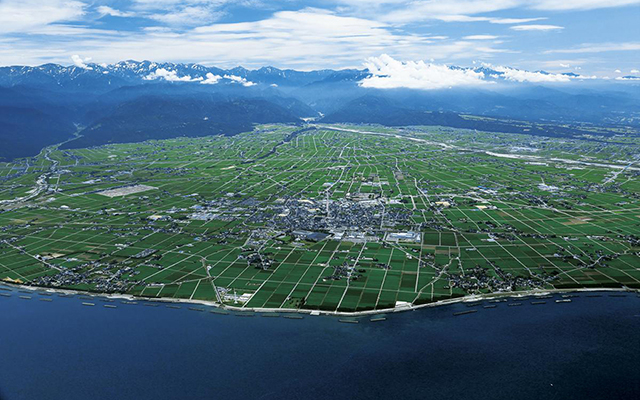
July 2023

